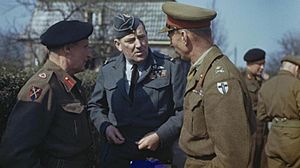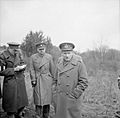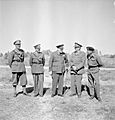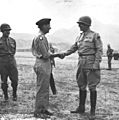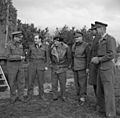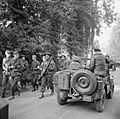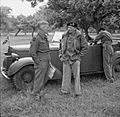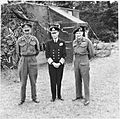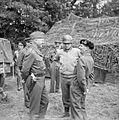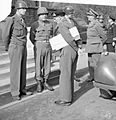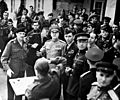Bernard Montgomery facts for kids
Quick facts for kids
|
|
|---|---|
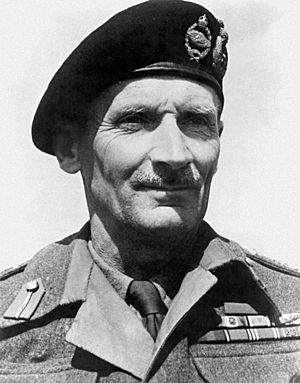
Montgomery wearing his beret with two cap badges.
|
|
| Nickname(s) | Monty |
| Place of burial |
Holy Cross Churchyard, Binsted
|
| Allegiance | |
| Service/ |
|
| Years of service | 1908–1958 |
| Rank | Field Marshal |
| Commands held | Eighth Army 1942–1943 Allied 21st Army Group 1943–1945 Chief of the Imperial General Staff 1946–1948 Deputy Supreme Commander Europe of NATO 1951–1958 |
| Battles/wars | World War I Anglo-Irish War Arab revolt in Palestine World War II |
| Awards | KG (1946) GCB (1945) KCB (1942) CB (1940) DSO (1914) MID (1915, 1917, 1917, 1918, 1919, 1939, 1943, 1944) Distinguished Service Medal (US) (1947) Legion of Merit (Chief Commander) (USA) (1943) Order of Victory (USSR) (1945) Croix de Guerre (France) (1919) Order of the Elephant (Denmark) (1945) Order of King George I, Grand Commander (Greece) (1944) Virtuti Militari V Class (Poland) (1944) Order of the White Lion, Grand Cross (Czech.) (1947) Grand Cordon of the Seal of Solomon (Ethiopia) (1949) Order of Leopold II, Grand Officer (Belgium) (1947) Order of St. Olav, Grand Cross (Norway) (1951) |
| Other work | Colonel Commandant, Royal Tank Regiment Colonel Commandant, Parachute Regiment ( -1956) Representative Colonel Commandant, Royal Armoured Corps (1947-1957) Colonel Commandant, Army Physical Training Corps (1946-1960) Colonel Royal Warwickshire Regiment(1947-1963) Deputy Lieutenant of Southampton (1958-) |
| Signature | |
Field Marshal Bernard Law Montgomery, also known as "Monty", was a very important British Army officer. He was born on 17 November 1887 and died on 24 March 1976. He fought in World War I and became famous during World War II. He successfully led Allied forces at the Second Battle of El Alamein, which was a major turning point in the war in North Africa. Later, he played a key role in battles in Italy and North-West Europe, including the Battle of Normandy and Operation Market Garden. After the war, he held high positions, like Commander-in-Chief of British forces in Germany and Chief of the Imperial General Staff.
Contents
Early Life and Military Start
Bernard Montgomery was born in Kennington, London, in 1887. He was one of nine children. His father, Henry Montgomery, was an Anglican priest, and his mother was Maud Montgomery. The family moved to Tasmania when his father became a Bishop. Bernard later described himself as a "dreadful little boy" during his childhood.
He attended St Paul's School and then the Royal Military Academy, Sandhurst. After graduating, he joined the 1st Battalion, The Royal Warwickshire Regiment in September 1908. He served in India until 1913 and was promoted to lieutenant in 1910.
First World War Experience
When World War I began in August 1914, Montgomery went to France with his regiment. His battalion suffered heavy losses during the retreat from Mons. On 13 October 1914, he was shot in the right lung by a sniper and was severely wounded. A Platoon sergeant fell on him, protecting him from further enemy fire. Montgomery was also hit in the knee.
For his brave leadership, he received the Distinguished Service Order. The official note said he showed "Conspicuous gallant leading" when he used a bayonet to clear enemy trenches. In 1915, he trained new soldiers for Kitchener's Army. He returned to the Western Front in 1916 as a staff officer, helping plan operations during major battles like the Somme, Arras, and Passchendaele. He learned the importance of different army units working together.
Montgomery also served in the battles of the Lys and Chemin-des-Dames. He finished the war as a senior staff officer for the 47th (2nd London) Division, with the temporary rank of lieutenant-colonel.
Second World War Leadership
Britain declared war on Germany on 3 September 1939. Montgomery's 3rd Division was sent to Belgium as part of the British Expeditionary Force (BEF). He focused on training his troops for a safe retreat, which proved very useful. When Germany invaded in May 1940, his division expertly withdrew to Dunkirk with few casualties. During the evacuation, Montgomery took command of the II Corps.
Back in Britain, Montgomery was put in charge of defending Hampshire and Dorset. He was known for being strict and demanding high fitness levels from his soldiers. He would remove officers he felt were not ready for battle. In December 1941, he took command of South-Eastern Command, which he renamed the South-Eastern Army to encourage an attacking spirit. He continued to train his soldiers, leading a large exercise called Exercise Tiger in May 1942.
North Africa and Italy Campaigns
Taking Command in the Desert
In 1942, a new commander was needed for the Eighth Army in the Middle East. After a visit, Prime Minister Winston Churchill chose Montgomery for the role. Montgomery quickly became very popular with the soldiers of the Eighth Army. He improved their fighting spirit and skills.
He took command on 13 August 1942 and immediately started making changes. He created two main groups: X Corps for all armoured divisions and XXX Corps for all infantry divisions. He also moved his headquarters closer to the Air Force to help the Army, Navy, and Air Force work better together. Montgomery ordered all plans for retreat to be destroyed, telling his officers, "If we cannot stay here alive, then we will stay here dead."
He made an effort to meet his troops often, visiting units and talking to the men. He became known for wearing a black beret with the badge of the Royal Tank Regiment.
First Battles with Rommel
The German commander, Erwin Rommel, attacked the Eighth Army at the Battle of Alam Halfa on 31 August 1942. Montgomery's forces successfully stopped the German and Italian attack. Rommel's troops had to retreat quickly. Montgomery was criticized for not attacking them right away, but he wanted to wait until his forces were fully ready for a major offensive.
He prepared very carefully for the next big attack. He gathered many resources, planned every detail, and trained his troops, especially in clearing minefields and fighting at night. He also used many new American-built Sherman tanks. By late October, the Eighth Army had 231,000 men, including British, Australian, South African, Indian, New Zealand, Greek, and Free French units.
Victory at El Alamein
The Second Battle of El Alamein began on 23 October 1942. It lasted twelve days and was the first major, decisive Allied land victory of the war. Montgomery had correctly predicted how long the battle would last and how many casualties there would be. After British forces broke through the German and Italian lines, a heavy rainstorm slowed down the pursuit. Even so, the Battle of El Alamein was a huge success. Over 30,000 enemy soldiers were captured.
Pushing Through Tunisia
After El Alamein, Montgomery was knighted and promoted to full general. The Eighth Army chased the Germans hundreds of miles towards Tunisia. Montgomery kept the pressure on, using his army's strength to force Rommel out of each defensive position. This campaign showed how important good morale, teamwork between different army branches, and clear orders were for winning battles. For his role in North Africa, he received the Legion of Merit from the United States.
Invading Sicily and Italy
The next big Allied attack was the Allied invasion of Sicily (Operation Husky). Montgomery thought the original plans were not good because they spread the troops too much. He managed to get the plans changed to focus the Allied forces more. This led to some tension with American commanders like Patton and Bradley, who felt Montgomery was boastful, even though they respected his skills.
In the autumn of 1943, Montgomery continued to lead the Eighth Army during the landings on mainland Italy. He led his army up the toe of Italy. Some people criticized his advance for being too slow.
Normandy and Beyond
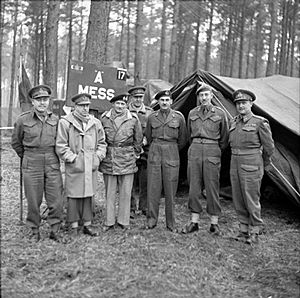
Montgomery returned to Britain to command the 21st Army Group. This group included all Allied ground forces for Operation Overlord, the invasion of Normandy. His plan was to trap and defeat German forces in Normandy, leading to the Falaise pocket. By mid-July, the Cotentin Peninsula was taken, and Caen was captured.
Advance to the Rhine
As more American troops arrived in Europe, General Eisenhower took over command of all ground forces, while Montgomery continued to lead the 21st Army Group, mainly made up of British and Canadian units. Montgomery was unhappy about this change, even though it had been planned. Winston Churchill had Montgomery promoted to Field Marshal as a way to make up for it.
Montgomery convinced Eisenhower to try his plan for a single strong push into the Ruhr region with Operation Market Garden in September 1944. This operation was very bold but poorly planned. It failed, leading to the destruction of the British 1st Airborne Division at the Battle of Arnhem. This meant there was no hope of invading Germany by the end of 1944.
Montgomery's focus on the Ruhr also meant he didn't clear the Scheldt river quickly enough to open the port of Antwerp. After Arnhem, his group was told to focus on clearing the Scheldt so supplies could reach the Allied armies.
When the Germans launched a surprise attack in the Battle of the Bulge on 16 December 1944, Montgomery quickly took charge of some American armies. He organized the defense and helped stop the German advance. A German commander, Hasso von Manteuffel, praised Montgomery for turning "a series of isolated actions into a coherent battle fought according to a clear and definite plan."
Montgomery's 21st Army Group advanced to the Rhine river in February 1945. A carefully planned Rhine crossing happened on 24 March. This was successful, but it happened weeks after the Americans had already crossed the river at Remagen. After crossing the Rhine, Montgomery's forces helped surround the German Army Group B in the Ruhr.
On 4 May 1945, on Lüneburg Heath, Montgomery accepted the surrender of German forces in northern Germany, Denmark, and the Netherlands. This was done simply, without much ceremony.
After the War
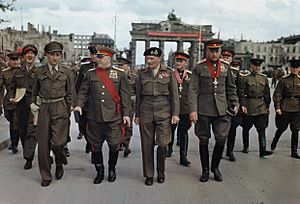
After the war, Montgomery became the Commander-in-Chief of the British forces occupying Germany. He was made the 1st Viscount Montgomery of Alamein in 1946. He also served as Chief of the Imperial General Staff from 1946 to 1948.
Later, he became Chairman of the Western European Union's military committee. In 1951, he became Eisenhower's deputy in setting up the NATO forces in Europe. He was good at inspecting troops and organizing exercises. He retired in 1958 at nearly 71 years old.
In 1953, a new school in Hamilton, Canada, was named Viscount Montgomery Elementary after him. He called it his "beloved school" and visited it five times. He told the students to make it the best school and to always do their best.
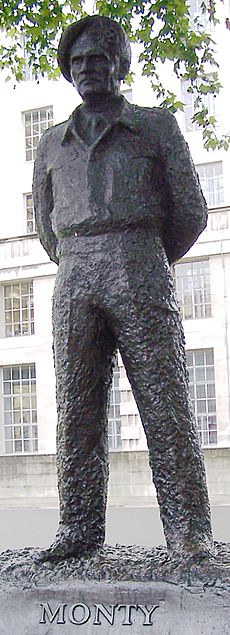
Montgomery wrote his memoirs in 1958, where he criticized some of his wartime colleagues, including Eisenhower. This ended their friendship. He was even challenged to a duel by an Italian officer! He also had to publicly thank Field-Marshal Auchinleck after suggesting in his book that Auchinleck had planned to retreat from El Alamein, which was not true.
Montgomery was never given the higher title of earl, unlike some other wartime commanders. In his later years, he insisted on carrying the Sword of State during the State Opening of Parliament. However, he became very frail and collapsed during the ceremony in 1968, after which he no longer performed this duty.
Images for kids
-
Lieutenant-General Alan Brooke, GOC II Corps, with Major-General Bernard Montgomery, GOC 3rd Division, and Major-General Dudley Johnson, GOC 4th Infantry Division, pictured here in either 1939 or 1940.
-
Montgomery inspecting men of the 7th Battalion, Suffolk Regiment, at Sandbanks near Poole, Dorset, 22 March 1941. To his right, wearing a peaked cap, is Brigadier Gerald Templer, commanding the 210th Brigade, the 7th Suffolks' parent formation.
-
Lieutenant-General Bernard Montgomery, the new commander of the British Eighth Army, and Lieutenant-General Brian Horrocks, the new GOC XIII Corps, discussing troop dispositions at 22nd Armoured Brigade HQ, 20 August 1942. The brigade commander, Brigadier George Roberts is on the right (in beret).
-
The British Prime Minister Winston Churchill with military leaders during his visit to Tripoli. The group includes: Lieutenant-General Sir Oliver Leese, General Sir Harold Alexander, General Sir Alan Brooke and General Sir Bernard Montgomery.
-
From left to right: Freddie de Guingand, Harry Broadhurst, Sir Bernard Montgomery, Sir Bernard Freyberg, Miles Dempsey and Charles Allfrey
-
General Montgomery inspects men of the 5th/7th Battalion, Gordon Highlanders of the 51st (Highland) Division, at Beaconsfield, February 1944.
-
The King with Lieutenant-General Miles Dempsey, GOC British Second Army, and General Montgomery, at his HQ in Creullet, 16 June 1944
-
General Montgomery with Lieutenant Generals George S. Patton (left) and Omar Bradley (centre) at 21st Army Group HQ, 7 July 1944
-
Field Marshal Sir Bernard Montgomery talking with Lieutenant General Simpson, GOC U.S. Ninth Army and Major General John Anderson, GOC U.S. XVI Corps. Behind are General Bradley and Field Marshal Sir Alan Brooke.
-
Montgomery was awarded the Order of Victory on 5 June 1945. Dwight Eisenhower, Georgy Zhukov and Sir Arthur Tedder were also present.
-
Montgomery in New Zealand in 1947
-
Montgomery's Grant command tank, on display at the Imperial War Museum in London
-
Montgomery's Garter banner on display in St Mary's, Warwick.
-
Statue of Bernard Montgomery in Montgomery Square, Brussels
See also
 In Spanish: Bernard Law Montgomery para niños
In Spanish: Bernard Law Montgomery para niños



